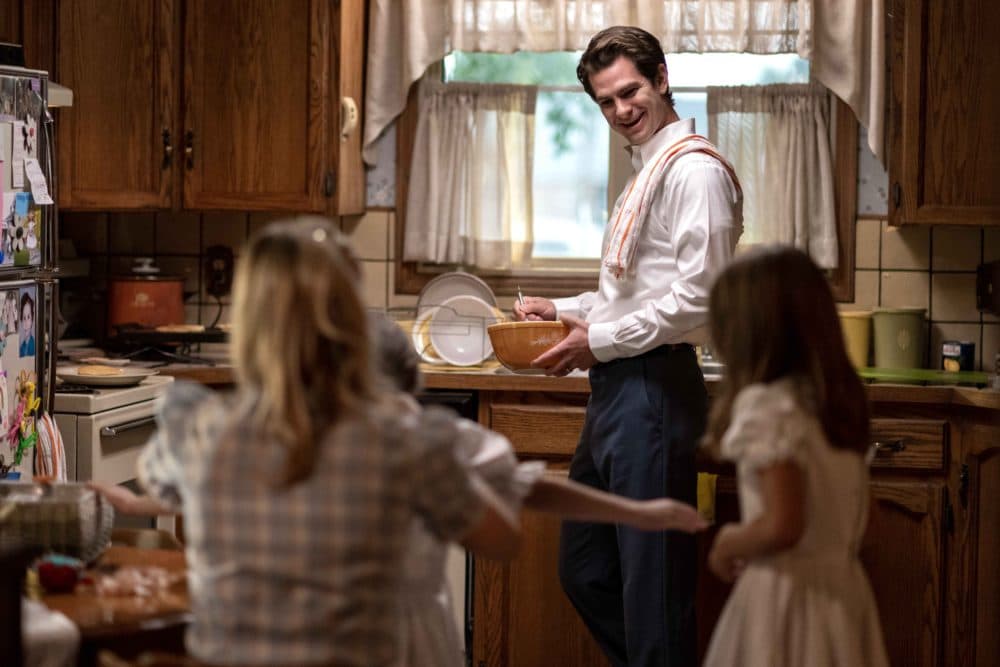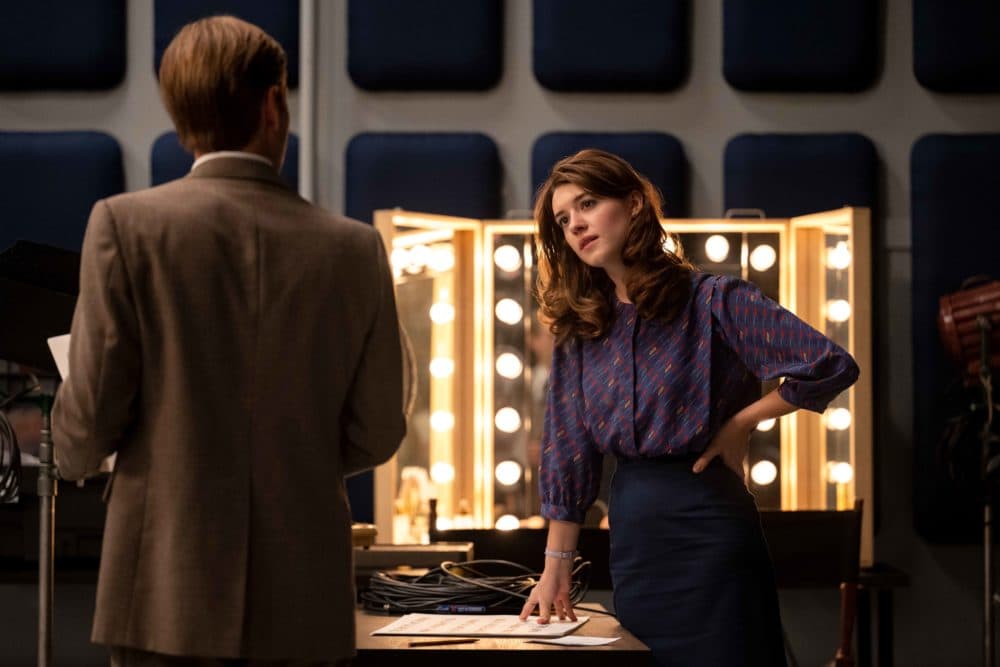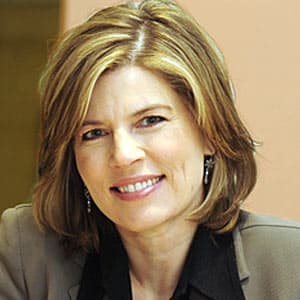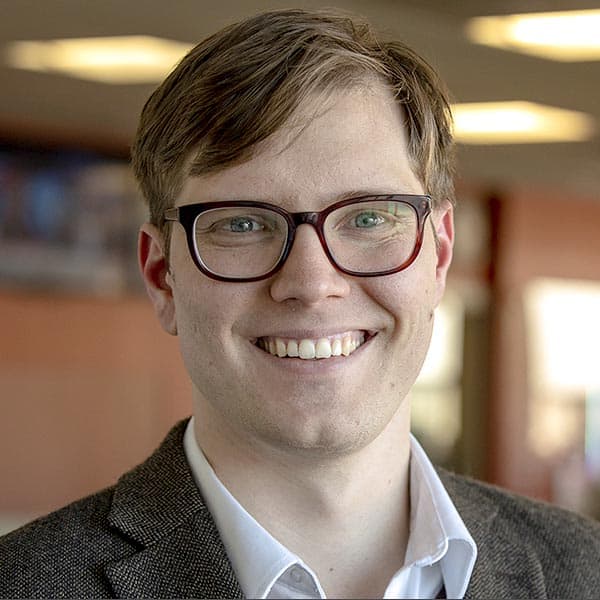Advertisement
What 'Under the Banner of Heaven' gets right — and wrong — about Mormons
Resume
FX's new series "Under the Banner of Heaven" dramatizes the real-life 1984 murder of Brenda Lafferty and her 15-month-old child in a Mormon community.
Told through the perspective of fictional detective Jeb Pyre (played by Andrew Garfield), the series, like the bestselling 2003 book before it, links the brutal crime to the history of the Church of Jesus Christ of Latter-day Saints.
Showrunner Dustin Lance Black grew up in the church. The acclaimed screenwriter behind “Big Love” and “Milk” worked to adapt the book for years before it took form as a miniseries.
While Black has detailed the extensive research he put into the series, others including columnist and author Jana Riess feel the show mischaracterizes the faith. She’s senior columnist for Religion News Service and author of “The Next Mormons: How Millennials are Changing the LDS Church.”
“The most troubling aspect to me is the basic idea that if you simply scratch under the surface of a seemingly respectable religion, all sorts of violent acts and thoughts are going to come pouring out,” Riess says. “I just don't think that that's true of my people.”
Interview Highlights
On how the series represents everyday members of the Church of Jesus Christ of Latter-day Saints
“So let's talk about the good things first … This character played by Andrew Garfield, he is a loving family man. He's trying to do his best with this horrific murder case. What he discovers as he investigates the case is that it deals with offshoot Mormon groups that still practice polygamy [the practice of marrying of multiple wives]. In Mormon history, both Joseph Smith and Brigham Young and several other key leaders practiced polygamy. They believed it was a religious principle. I have my doubts about that, to be honest. But it is a fact of Mormon history that this happened.”
On how the show links early Mormon history to the 1984 Lafferty murders
“So it goes back to look at Joseph Smith, the founding prophet, and then his successor, Brigham Young. After Joseph Smith was assassinated, Brigham Young took over and took the Mormons West. And it kind of draws this straight line to the present day and makes the case that Mormonism has not changed at all.
"I really don't [think that's fair]. And it's not because I am incapable of being critical of my church. In my column, I do take the church to task sometimes for various things like the role of women, like the history that denied African-Americans the right to be blessed in the temple. There are things that I criticize about the church.”
On whether the ‘Under the Banner of Heaven’ properly distinguishes between extremists and mainstream Mormons
“I think it is trying to do so and I think it does a better job at that than the book did. I would also say that with the dramatization, particularly of Brigham Young, that is told in these flashbacks into Mormon history, later on in the series around episode five, they're making this claim. It's a little bit subtle, but it seems to be there: that Brigham Young somehow engineered the death of Joseph Smith and that he was, "running the church in the months before Joseph's death." I had to rewind that and make sure that I was hearing it correctly, because that is so completely not true. Brigham Young wasn't even in Nauvoo, which is where the Mormons were living at the time. He was on a mission in the Eastern states that was part religious and part also as a campaign for Joseph Smith's run for president. So he wasn't even on the scene. And so for the show to make a claim that he is somehow engineering these events that culminate in the assassination of Joseph Smith is really problematic.”
On how the show links polygamy to the Lafferty murders
“So the Lafferty brothers, again, these are the in-laws that Brenda, the one who winds up getting murdered, has married into. This is the family. Several of the brothers become enamored of early church teachings, not only polygamy, but a very violent teaching called blood atonement. They kind of resurrect that and use it as justification for killing people who they see as enemies of God, including Brenda, who was more progressive and not as obedient as they felt that women should be.”

On how the show portrays women in the Church of Jesus Christ of Latter-day Saints
“In some ways, I think that is more accurate. You know, that particular clip is of Brenda and her young husband who, of his brothers, they are probably the most progressive in that she has a college education. She wants to have a career. And the early 1980s, the time in which this is set, is a time when the prophet of the LDS Church tells women, you need to be home with your children. The church has changed a lot in that way as well. There's so much more work to be done. But work has happened since the early 1980s. Absolutely.”
On how the show depicts violence in Mormon history, particularly the Mountain Meadows Massacre
“Well, it's told in flashbacks. So the crime actually happened in 1857. In fact, it was on Sept. 11, which people have seen as a significant coincidence. This emigrant train is coming from Arkansas on their way to California. And when they're passing through Utah, they get into a skirmish that winds up far, far worse than that. And 120 some emigrants are killed, including children over the age of 8. It's the most chilling episode in all of Mormon history. I think we don't talk about it enough in the church. We don't have those conversations that we need to be having, of how could this have happened among our people? So if there's good work that will be done in the Mormon community because of ‘Under the Banner of Heaven,’ perhaps that will be part of it. But to somehow claim that that was anything more than an anomaly in Mormon history, to claim that that is the underlying drive of 16 plus million people who are members of this faith is a fallacy.”
On whether the show brings up important issues for church members to address
“I think that there are a number of historical events and theological concepts that Mormons have not grappled with publicly in the way that we probably should. What we've seen in the last decade in particular within the LDS Church is a greater emphasis on being transparent about history. The church has made the entire corpus of Joseph Smith's papers available to the public. So there's nothing hidden. There's still progress to be made. But it's starting.”
James Perkins Mastromarino produced and edited this interview for broadcast with Gabe Bullard. Perkins Mastromarino also adapted it for the web.
This segment aired on May 4, 2022.


